In this edition:
- W2RS Memorial AMSAT CW Activity Day
- ARISS SSTV Event Underway
- N4AKV Earns AMSAT VUCC Award/r
- GridMasterMap Satellite Top 100 Rovers January 2025 Rankings
- NASA’s Deep Space Network Upgraded
- Changes to AMSAT TLE Distribution for December 27, 2024
- ARISS News
- Upcoming Satellite Operations
- AMSAT Ambassador Activities
- Satellite Shorts From All Over
The AMSAT News Service bulletins are a free, weekly news and information service of AMSAT, the Radio Amateur Satellite Corporation. ANS publishes news related to Amateur Radio in Space including reports on the activities of a worldwide group of Amateur Radio operators who share an active interest in designing, building, launching and communicating through analog and digital Amateur Radio satellites.
The news feed on http://www.amsat.org publishes news of Amateur Radio in Space as soon as our volunteers can post it.
Please send any amateur satellite news or reports to: ans-editor [at] amsat [dot] org.
You can sign up for free e-mail delivery of the AMSAT News Service Bulletins via the ANS List; to join this list see: https://mailman.amsat.org/postorius/lists/ans.amsat.org/
ANS-364 AMSAT News Service Weekly Bulletins
To: All RADIO AMATEURS
From: Radio Amateur Satellite Corporation
712 H Street NE, Suite 1653
Washington, DC 20002
DATE 2024 Dec 29
W2RS Memorial AMSAT CW Activity Day
The Annual W2RS Memorial AMSAT CW Activity Day occurs each year on January 1st. The event runs 0000 UTC to 2359 UTC January on New Year’s Day.
In March 2022, the AMSAT community lost one of our pioneers when Ray Soifer, W2RS, became a silent key. In addition to his numerous contributions to AMSAT and the worldwide amateur satellite community, Ray was also the long time organizer of AMSAT’s CW Activity Day – previously AMSAT Straight Key Night – held in conjunction with the ARRL’s event on New Year’s Day.
In recognition of Ray’s long time service to AMSAT and his keen interest in CW operating via satellite, AMSAT’s CW Activity Day is now known as the W2RS Memorial AMSAT CW Activity Day.
Send your reports including stations worked and satellites used to info at amsat dot org.
[ANS thanks Bruce Paige, KK5DO, AMSAT Director of Contests and Awards for the above information.]
ARISS SSTV Event Underway
Well underway for the holidays and New Year, ARISS’ Slow Scan Television (SSTV) event began on December 25 and will continue until January 5, 2025.
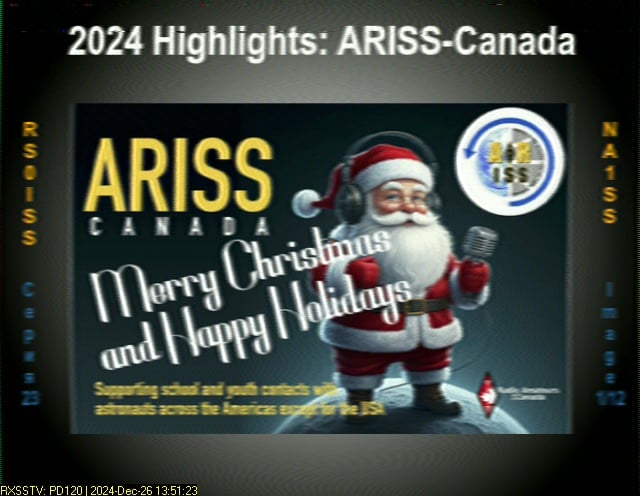
Series 23 consists of 12 pictures celebrating ARISS memories of 2024. Ending time for the transmissions is tentatively January 5 at 14: 20 UTC.
On the ISS, the Service Module radio is being used and the ISS callsign is RS0ISS; Images are transmitted on 145.800 MHz FM and the SSTV mode is PD120.
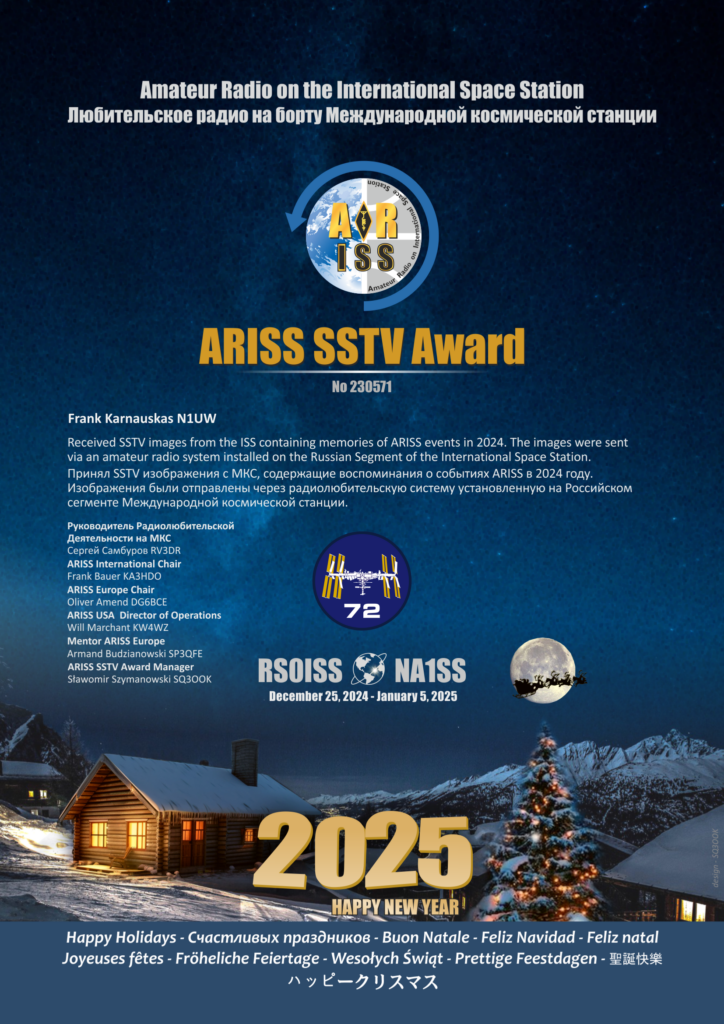
Everyone is invited to upload their decoded images in the ARISS gallery, area “Series 23 Holiday 2025” at: https://ariss-usa.org/ARISS_SSTV. Once you’ve submitted your image, just click on the dedicated button and you can apply for the official ARISS SSTV award.
Also, European stations can request the ARISS QSL by contacting the European QSL bureau: https://www.ariss-eu.org/index.php/ariss-station/european-qsl-bureau.
To support everyone interested in such events, the European Space Agency released tutorials about how to receive pictures transmitted over amateur radio by the International Space Station: you can find them on https://issfanclub.eu/2024/11/08/esa-tips-how-to-get-pictures-from-the-international-space-station-via-amateur-radio-2/
No two-meter radio? it’s always possible to decode the audio signals coming from the WebSDR at Goonhilly Earth Station https://vhf-goonhilly.batc.org.uk/
Follow @ARISS_intl on X for official updates, since changes can occur.
Reminder, the images are sent on a (roughly) 2 minutes on, 2 minutes off schedule. So if you don’t hear anything, give it wait two minutes.
Many FM rigs can be switched been wide and narrow deviation FM filters. For best results you should select the filter for wider deviation FM. Handhelds generally have a single wide filter fitted as standard. Free decoding software is available for Android and Apple smartphone. Check your phone’s app store by searching SSTV”. PC users can download the free RX-SSTV program.
You can get predictions for the ISS pass times at https://www.amsat.org/track/ or from a myriad of free smartphone apps.
More useful information to receive the pictures can be found at https://amsat-uk.org/beginners/iss-sstv/.
[ANS thanks AMSAT-NA and AMSAT-UK for the above information.]
The 2024 AMSAT President’s Club Coins Are Almost Gone!
ONLY 4 DAYS LEFT!
Help Support GOLF and Fox Plus
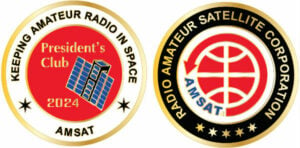
Join the AMSAT President’s Club today and help
Keep Amateur Radio in Space!
https://www.amsat.org/join-the-amsat-presidents-club/
N4AKV Earns AMSAT VUCC Award/r
Congratulations to Jonathan Eernisse, N4AKV, for his outstanding achievements in providing satellite contacts! Jonathan has roved an impressive 102 grid squares, earning him the AMSAT VUCC/r Award #19. The Reverse VUCC or VUCC/r Award, originally introduced by the Central States VHF Society and now carried on by AMSAT, recognizes the dedication of satellite rovers like Jonathan. For more information about this prestigious award, you can visit the AMSAT website at https://www.amsat.org/reverse-vucc-or-vucc-r-award.
Keep on roving, Jonathan, and continue to inspire others in the AMSAT community with your remarkable achievements!
[ANS thanks Bruce Paige, KK5DO, AMSAT Director of Contests and Awards for the above information.]
GridMasterMap Satellite Top 100 Rovers January 2025 Rankings
The January 2025 rankings for the Top 100 Rovers (Mixed LEO/MEO/GEO) in satellite operations, as determined by @GridMasterMap on Twitter, has been released. The ranking is determined by the number of grids and DXCC entities activated, taking into account only those grids where a minimum number of QSOs logged on the gridmaster.fr website have been validated by a third party. Grid numbers do not directly reflect the exact number of activations. Satellite operators are encouraged to upload their LoTW satellite contacts to https://gridmaster.fr in order to provide more accurate data. Figures updated December 26, 2024.
| 1 | ND9M | 26 | KX9X | 51 | W7WGC | 76 | LU4JVE |
| 2 | NJ7H | 27 | ON4AUC | 52 | N6DNM | 77 | AA8CH |
| 3 | JA9KRO | 28 | KG5CCI | 53 | JK2XXK | 78 | VE1VOX |
| 4 | UT1FG | 29 | N5BO | 54 | EA4NF | 79 | FG8OJ |
| 5 | N5UC | 30 | K8BL | 55 | SM3NRY | 80 | YU0W |
| 6 | DL6AP | 31 | KE4AL | 56 | JL3RNZ | 81 | PT9BM |
| 7 | OE3SEU | 32 | KB5FHK | 57 | DF2ET | 82 | KJ7NDY |
| 8 | WI7P | 33 | VE3HLS | 58 | XE1ET | 83 | KI7UXT |
| 9 | DP0POL | 34 | PA3GAN | 59 | AA5PK | 84 | N6UTC |
| 10 | K5ZM | 35 | KI0KB | 60 | KI7QEK | 85 | KB2YSI |
| 11 | F5VMJ | 36 | KI7UNJ | 61 | SP5XSD | 86 | N4DCW |
| 12 | N6UA | 37 | LA9XGA | 62 | F4DXV | 87 | WA9JBQ |
| 13 | HA3FOK | 38 | JO2ASQ | 63 | AD7DB | 88 | JM1CAX |
| 14 | WY7AA | 39 | F4BKV | 64 | VE1CWJ | 89 | AF5CC |
| 15 | N9IP | 40 | BA1PK | 65 | KE9AJ | 90 | VE3GOP |
| 16 | W5PFG | 41 | N7AGF | 66 | DL4EA | 91 | BG7QIW |
| 17 | AK8CW | 42 | VK5DG | 67 | N8RO | 92 | N0TEL |
| 18 | DL2GRC | 43 | VA3VGR | 68 | VA7LM | 93 | KG4AKV |
| 19 | AD0DX | 44 | XE3DX | 69 | KM4LAO | 94 | W8MTB |
| 20 | LU5ILA | 45 | KE0WPA | 70 | M1DDD | 95 | K0FFY |
| 21 | N4AKV | 46 | PR8KW | 71 | W8LR | 96 | CU2ZG |
| 22 | AD0HJ | 47 | K7TAB | 72 | W1AW | 97 | VE7PTN |
| 23 | WD9EWK | 48 | KE0PBR | 73 | N4UFO | 98 | K6VHF |
| 24 | ND0C | 49 | EB1AO | 74 | HB9GWJ | 99 | VE6WK |
| 25 | DJ8MS | 50 | AC0RA | 75 | PT2AP | 100 | DK9JC |
[ANS thanks @GridMasterMap for the above information.]
Need new satellite antennas?
Purchase M2 LEO-Packs from the AMSAT Store.
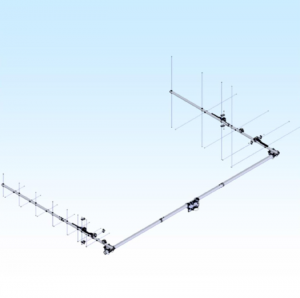
When you purchase through AMSAT, a portion of the proceeds goes towards
Keeping Amateur Radio in Space.
https://amsat.org/product-category/hardware/
NASA’s Deep Space Network Upgraded
Installation of the latest antenna took place on Dec. 18, when teams at NASA’s Goldstone Deep Space Communications Complex near Barstow, California, installed the metal reflector framework for Deep Space Station 23, a multifrequency beam-waveguide antenna. When operational in 2026, Deep Space Station 23 will receive transmissions from missions such as Perseverance, Psyche, Europa Clipper, Voyager 1, and a growing fleet of future human and robotic spacecraft in deep space.
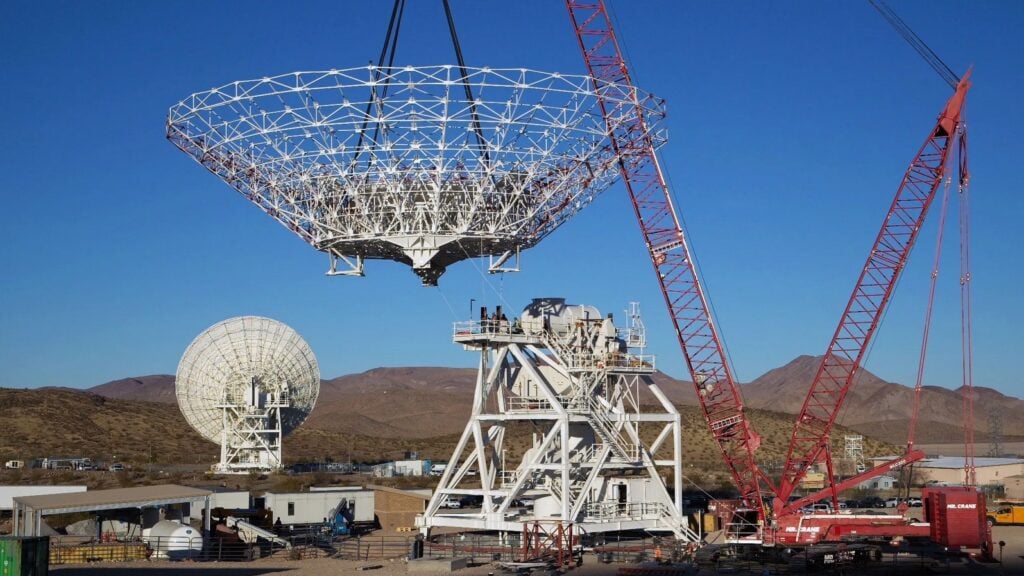
“This addition to the Deep Space Network represents a crucial communication upgrade for the agency,” said Kevin Coggins, deputy associate administrator of NASA’s SCaN (Space Communications and Navigation) program. “The communications infrastructure has been in continuous operation since its creation in 1963, and with this upgrade we are ensuring NASA is ready to support the growing number of missions exploring the Moon, Mars, and beyond.
“With the Deep Space Network, we are able to explore the Martian landscape with our rovers, see the James Webb Space Telescope’s stunning cosmic observations, and so much more,” said Laurie Leshin, director of JPL. “The network enables over 40 deep space missions, including the farthest human-made objects in the universe, Voyager 1 and 2. With upgrades like these, the network will continue to support humanity’s exploration of our solar system and beyond, enabling ground breaking science and discovery far into the future.”
Read the complete story at https://tinyurl.com/ANS-364-Deep-Space.
[ANS thanks NASA for the above information.]
Want to fly the colors on your own grid expedition?
Get your AMSAT car flag and other neat stuff from our Zazzle store!
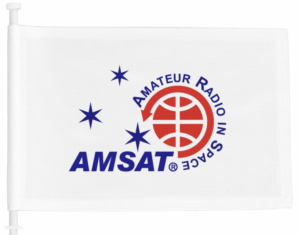
25% of the purchase price of each product goes towards
Keeping Amateur Radio in Space
https://www.zazzle.com/amsat_gear
Changes to AMSAT-NA TLE Distribution for December 27, 2024
Two Line Elements or TLEs, often referred to as Keplerian elements or keps in the amateur community, are the inputs to the SGP4 standard mathematical model of spacecraft orbits used by most amateur tracking programs. Weekly updates are completely adequate for most amateur satellites. TLE bulletin files are updated daily in the first hour of the UTC day. New bulletin files will be posted immediately after reliable elements become available for new amateur satellites. More information may be found at https://www.amsat.org/keplerian-elements-resources/.
The following satellites have been removed from this week’s AMSAT TLE distribution:
SSS-2B Catalog No. 56184: Decayed from orbit on or about 23 December 2024.
[ANS thanks Joe Fitzgerald, KM1P, AMSAT Orbital Elements Manager, for the above information.]
ARISS NEWS
Amateurs and others around the world may listen in on contacts between amateurs operating in schools and allowing students to interact with astronauts and cosmonauts aboard the International Space Station. The downlink frequency on which to listen is 145.800 MHz worldwide.

Upcoming Contacts
ARISS school contacts are currently planned to resume the week of 2025-01-13 to 2025-01-19.
The Slow Scan TV experiment continues until January 5, 2025. Transmitting PD120 mode on 145.800 MHz.
The crossband repeater continues to be active (145.990 MHz up {PL 67} & 437.800 MHz down). If any crewmember is so inclined, all they have to do is pick up the microphone, raise the volume up, and talk on the crossband repeater. So give a listen, you just never know.
The packet system is also active (145.825 MHz up & down).
As always, if there is an EVA, a docking, or an undocking; the ARISS radios are turned off as part of the safety protocol.
Note, all times are approximate. It is recommended that you do your own orbital prediction or start listening about 10 minutes before the listed time.
The latest information on the operation mode can be found at https://www.ariss.org/current-status-of-iss-stations.html
The latest list of frequencies in use can be found at https://www.ariss.org/contact-the-iss.html
[ANS thanks Charlie Sufana, AJ9N, one of the ARISS operation team mentors for the above information.]
Upcoming Satellite Operations
No operations listed as of December 23, 2024.
A growing number of satellite rovers are currently engaged in sharing their grid square activations on https://hams.at. By visiting the website, you gain easy access to comprehensive information about the operators responsible for activating specific grid squares. Additionally, you have the ability to assess the match score between yourself and a particular rover for a given pass, while also being able to identify the upcoming satellite passes that are accessible from your location.
[ANS thanks Ian Parsons, K5ZM, AMSAT Rover Page Manager for the above information.]
AMSAT Ambassador Activities
AMSAT Ambassadors provide presentations, demonstrate communicating through amateur satellites, and host information tables at club meetings, hamfests, conventions, maker faires, and other events.
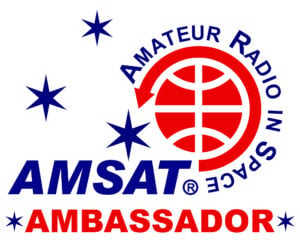
January 8, 2025
West Valley Amateur Radio Association (WVARA) – Monthly Meeting – 7:00 PM
“Build A Satellite Roving Station for Your Next Road Trip or POTA Activation”
Santa Clara Valley American Red Cross
2731 N. 1st St.
San Jose, CA 95134
https://wvara.org/wordpress/
WU0I
January 11, 2025
Gwinnett Amateur Radio Society – TechFest
Gwinnett County Fairgrounds
Expo Center Building
2405 Sugarloaf Pkwy.
Lawrenceville, GA 30045
http://www.techfest.info/
K4RGK
February 14-15, 2025
Yuma HAMCON and Southwestern Division Convention
Yuma County Fairgrounds
Yuma, AZ
https://www.yumahamfest.com/
N1UW
Interested in becoming an AMSAT Ambassador? AMSAT Ambassadors provide presentations, demonstrate communicating through amateur satellites, and host information tables at club meetings, hamfests, conventions, maker faires, and other events.
For more information go to: https://www.amsat.org/ambassador/
[ANS thanks Bo Lowrey, W4FCL, Director – AMSAT Ambassador Program for the above information.]
Satellite Shorts From All Over
Tom Schuessler, N5HYP is looking for volunteers for the upcoming Fort Worth Cowtown Hamfest. “The dates have slipped up on me, but, the hamfest is only three weekends away, January 17 and 18. Cowtown Hamfest, Fort Worth Texas. I have booked table space and at least one presentation for the weekend. Therefore, I Am looking for additional volunteers to help man the table, do demos and just talk amateur radio in space. The Cowtown club was the home of the late Keith Pugh, W5IU, who was an AMSAT Ambassador and ARISS mentor for many years before his passing. The Cowtown club recently dedicated a satellite station at their clubhouse in his honor and with some of his donated hardware. All this to say that the Cowtown Hamfest is a friend of AMSAT and so it is always good for us to make a good showing.” Contact Tom Schuessler via tschuessler (at) amsat.org or n5hyp (at) arrl (dot)net for more information or to volunteer. [ANS thanks Tom Schuessler, N5HYP, AMSAT Ambassador for the above information.]
The ARRL Teachers Institute on Wireless Technology continues to grow. Fresh off a highly successful YouTube telethon that raised more than $41,000 for the program, some of next year’s dates have been announced. Applications are now open. The program is growing, and educators will have the opportunity to attend sessions around the country. “We love having the teachers here at ARRL Headquarters, but we wanted to bring this program nationwide,” said ARRL Education and Learning Manager Steve Goodgame, K5ATA. Dates and details of the regional sessions are still being determined, but the hope is to touch many areas of the United States. The application process is straightforward. Interested educators can find the web form at www.arrl.org/ti. ARRL covers all the costs of the TI, including travel, but there is a $100 application fee if the teacher is accepted. More information available at https://tinyurl.com/ANS-364-Teachers. [ANS thanks the ARRL for the above information.]
The 39th Annual Small Satellite Conference is scheduled for August 11-13, 2025. The event will be held at the Salt Palace Convention Center in Salt Lake City, Utah. Persons wanting to submit an abstract for a talk, poster or flash talk must submit their abstract by February 4, 2025 to be considered. Educators and researchers at universities can also apply for a University Exhibit. Complete information is available at https://smallsat.org/. [ANS thanks SmallSat.org for the above information.
Join AMSAT today at https://launch.amsat.org/
In addition to regular membership, AMSAT offers membership to:
- Societies (a recognized group, clubs or organization).
- Primary and secondary school students are eligible for membership at one-half the standard yearly rate.
- Post-secondary school students enrolled in at least half time status shall be eligible for the student rate for a maximum of 6 post-secondary years in this status.
- Memberships are available for annual and lifetime terms.
Contact info [at] amsat [dot] org for additional membership information.
73 and remember to help Keep Amateur Radio in Space!
This week’s ANS Editor, Frank Karnauskas, N1UW
f.karnauskas [at] amsat [dot] org
